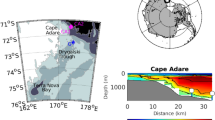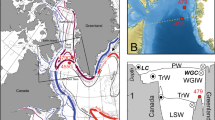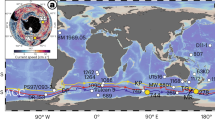Abstract
Past changes in the freshwater balance of the surface North Atlantic Ocean are thought to have influenced the rate of deep-water formation, and consequently climate1,2. Although water-mass proxies are generally consistent with an impact of freshwater input on meridional overturning circulation3, there has been little dynamic evidence to support this linkage. Here we present a 25,000 year record of variations in sediment grain size from south of Iceland, which indicates vigorous bottom-water currents during both the last glacial maximum and the Holocene period. Together with reconstructions of North Atlantic water-mass distribution, vigorous bottom currents suggest a shorter residence time of northern-source waters during the last glacial maximum, relative to the Holocene period. The most significant reductions in flow strength occur during periods that have been associated with freshening of the surface North Atlantic. The short-term deglacial oscillations in bottom current strength are closely coupled to changes in Greenland air temperature, with a minimum during the Younger Dryas cold reversal and a maximum at the time of rapid warming at the onset of the Holocene. Our results support a strong connection between ocean circulation and rapid climate change.
This is a preview of subscription content, access via your institution
Access options
Subscribe to this journal
Receive 12 print issues and online access
$259.00 per year
only $21.58 per issue
Buy this article
- Purchase on Springer Link
- Instant access to full article PDF
Prices may be subject to local taxes which are calculated during checkout



Similar content being viewed by others
References
Broecker, W. S. & Denton, G. H. The role of ocean–atmosphere reorganizations in glacial cycles. Geochim. Cosmochim. Acta 53, 2465–2501 (1989).
Manabe, S. & Stouffer, R. J. Simulation of abrupt climate change induced by freshwater input to the North Atlantic Ocean. Nature 378, 165–167 (1995).
Boyle, E. A. & Keigwin, L. North Atlantic thermohaline circulation during the past 20,000 years linked to high-latitude surface temperature. Nature 330, 35–40 (1987).
Worthington, L. V. On the North Atlantic Circulation (John Hopkins Press, Baltimore/London, 1976).
Duplessy, J. C. et al. Deepwater source variations during the last climatic cycle and their impact on global deepwater circulation. Paleoceanography 3, 343–360 (1988).
Oppo, D. W. & Lehman, S. J. Mid-depth circulation of the subpolar North Atlantic during the last glacial maximum. Science 259, 1148–1152 (1993).
Sarnthein, M. et al. Changes in east Atlantic deepwater circulation over the last 30,000 years: Eight time slice reconstructions. Paleoceanography 9, 209–267 (1994).
Curry, W. B. & Oppo, D. W. Glacial water mass geometry and the distribution of d13C of SCO2 in the western Atlantic Ocean. Paleoceanography 20, PA1017 (2005).
LeGrand, P. & Wunsch, C. Constraints from paleotracer data on the North Atlantic circulation during the last glacial maximum. Paleoceanography 10, 1011–1045 (1995).
McCave, I. N., Manighetti, B. & Beveridge, N. A. S. Circulation in the glacial North Atlantic inferred from grain-size measurements. Nature 374, 149–152 (1995).
McCave, I. N., Manighetti, B. & Robinson, S. G. Sortable silt and fine sediment size/composition slicing: Parameters for palaeocurrent speed and palaeoceanography. Paleoceanography 10, 593–610 (1995).
McCave, I. N. & Hall, I. R. Size sorting in marine muds; processes, pitfalls, and prospects for paleoflow-speed proxies. Geochem. Geophys. Geosyst. 7, 37 (2006).
Bianchi, G. & McCave, I. Holocene periodicity in North Atlantic climate and deep-ocean flow south of Iceland. Nature 397, 515–517 (1999).
Duplessy, J. C., Moyes, J. & Pujol, C. Deep water formation in the North Atlantic Ocean during the last ice age. Nature 286, 479–482 (1980).
Kroopnick, P. The distribution of 13C in the Atlantic Ocean. Earth Planet. Sci. Lett. 49, 469–484 (1980).
Bond, G. C. et al. Evidence for massive discharges of icebergs into the Northern Atlantic ocean during the last glacial period. Nature 360, 245–249 (1992).
Ruddiman, W. F. & McIntyre, A. The North Atlantic Ocean during the last deglaciation. Palaeogeogr. Palaeoclimatol. Palaeoecol. 35, 145–214 (1981).
Broecker, W. S. et al. Routing of meltwater from the Laurentide Ice Sheet during the Younger Dryas cold episode. Nature 341, 318–321 (1989).
Tarasov, L. & Peltier, W. R. Arctic freshwater forcing of the Younger Dryas cold reversal. Nature 435, 662–665 (2005).
Firestone, R. et al. Evidence for an extraterrestrial impact 12,900 years ago that contributed to the megafaunal extinctions and the Younger Dryas cooling. Proc. Natl Acad. Sci. 104, 16016–16021 (2007).
Kennett, J. P., Becker, L. & West, A. Triggering of the Younger Dryas cooling by extraterrestrial impact. Eos Trans. AGU Joint Assembly Supplement 88, PP41A-05 (2007).
Alley, R. B. et al. Holocene climatic instability: A prominent, widespread event 8,200 yr ago. Geology 25, 483–486 (1997).
Yu, E.-F., Francois, R. & Bacon, M. P. Similar rates of modern and last-glacial ocean thermohaline circulation inferred from radiochemical data. Nature 379, 689–694 (1996).
McManus, J. F., Francois, R., Gherardi, J., Keigwin, L. D. & Brown-Leger, S. Collapse and rapid resumption of Atlantic meridional circulation linked to deglacial climate changes. Nature 428, 824–837 (2004).
Gherardi, J.-M. et al. Evidence from the Northeastern Atlantic basin for variability in the rate of the meridional overturning circulation through the last deglaciation. Earth Planet. Sci. Lett. 240, 710–723 (2005).
Came, R. E., Oppo, D. W. & McManus, J. F. Amplitude and timing of salinity and temperature variability in the high-latitude North Atlantic. Geology 35, 315–318 (2007).
Ellison, C. R. W., Chapman, M. R. & Hall, I. R. Surface and deep ocean interactions during the cold climate event 8,200 years ago. Science 312, 1929–1932 (2006).
Hall, I. R., Bianchi, G. & Evans, J. R. Centennial to millennial scale Holocene climate–deep water linkage in the North Atlantic. Quat. Sci. Rev. 23, 1529–1536 (2004).
Rohling, E. J. & Pälike, H. Centennial-scale climate cooling with a sudden cold event around 8,200 years ago. Nature 434, 975–979 (2005).
Barber, D. C. et al. Forcing of the cold event 8,200 years ago by catastrophic draining of Laurentide lakes. Nature 400, 344–348 (1999).
Bard, E. et al. The North Atlantic atmosphere–sea surface 14C gradient during the Younger Dryas climatic event. Earth Planet. Sci. Lett. 126, 275–287 (1994).
McCartney, M. S., Curry, R. G. & Bezdek, H. F. North Atlantic’s transformation pipeline chills and redistributes subtropical water. Oceanus 39, 19–23 (1996).
Bianchi, G., Hall, I. R., McCave, I. & Joseph, L. Measurement of the sortable silt current speed proxy using the Sedigraph 5100 and Coulter Multisizer IIe: precision and accuracy. Sedimentology 46, 1001–1014 (1999).
Grootes, P. M., Stuiver, M., White, J. W. C., Johnsen, S. & Jouzel, J. Comparison of oxygen isotope records from the GISP2 and GRIP Greenland ice cores. Nature 366, 552–554 (1993).
Acknowledgements
This study was improved by assistance and technical support from M. Jeglinski.
Support for this research was provided in part by the US-NSF, the WHOI-OCCI and the Comer Science and Research Foundation.
Author information
Authors and Affiliations
Corresponding author
Supplementary information
Supplementary Information
Supplementary table and figure S1 (PDF 296 kb)
Rights and permissions
About this article
Cite this article
Praetorius, S., McManus, J., Oppo, D. et al. Episodic reductions in bottom-water currents since the last ice age. Nature Geosci 1, 449–452 (2008). https://doi.org/10.1038/ngeo227
Received:
Accepted:
Published:
Issue Date:
DOI: https://doi.org/10.1038/ngeo227
This article is cited by
-
A global synthesis of high-resolution stable isotope data from benthic foraminifera of the last deglaciation
Scientific Data (2023)
-
Hydroclimate response of spring ecosystems to a two-stage Younger Dryas event in western North America
Scientific Reports (2022)
-
Ice-rafted debris as a source of non-conservative behaviour for the εNd palaeotracer: insights from a simple model
Geo-Marine Letters (2020)
-
Stratigraphic correlation and splice generation for sediments recovered from a large-lake drilling project: an example from Lake Junín, Peru
Journal of Paleolimnology (2020)
-
Coherent deglacial changes in western Atlantic Ocean circulation
Nature Communications (2018)



